Science
This timeline chronicles scientific innovation and discovery in Canada
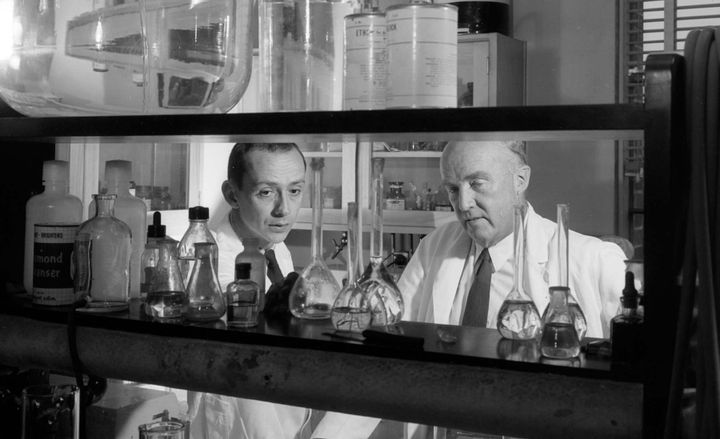
-
November 30, 1618
Science
First Comet Sighting
The first sighting of a comet by Europeans in Canada was recorded.
-
December 31, 1638
Science
Lunar Eclipse
A lunar eclipse was sighted in Huronia.
-
April 22, 1662
Science
Royal Society Chartered
King Charles II of England chartered the Royal Society of London, the oldest scientific organization in Britain.
-
December 25, 1758
Science
Halley's Comet Returns
As predicted by Edmond Halley in 1705, the comet of 1682 returned, the first ever predicted.
-
August 19, 1809
Science
Accommodation Launched
The first steamboat in Canada, the Accommodation, was launched at Montreal. Driven by two paddle wheels and powered by a steam engine, it heralded a new age and showed that Canadians could keep abreast of the latest technology.
-
July 20, 1854

Science
Work Begins on Victoria Bridge
The first stone, from the Kahnawake quarry, was laid on the abutment of the Victoria Bridge, spanning the St Lawrence River at Montreal.
-
July 17, 1860
Science
Total Eclipse Obscured
An American expedition, including Nova Scotia-born astronomer Simon Newcomb, arrived in northern Manitoba to observe a total eclipse, but were thwarted by clouds on the crucial day.
-
August 25, 1860

Science
Victoria Bridge Opened
The Prince of Wales presided over a ceremony officially opening the Victoria Bridge, spanning the St Lawrence River at Montreal. It was considered one of the engineering wonders of its day.
-
February 08, 1879
Science
Fleming's Standard Time
Sandford Fleming first proposed to divide the world into 24 equal time zones, with a standard time within each zone. His idea was adopted by 24 countries at a conference in 1884.
-
February 04, 1882
Science
Electricity comes to BC
The first electricity came to BC, at the Moodyville sawmill on Burrard Inlet, powering the first electric lights on the Pacific coast north of San Francisco.
-
December 30, 1882
Science
Royal Society of Canada
The Royal Society of Canada was founded by the governor general, the Marquis of Lorne.
-
November 18, 1883
Science
Standard Time Adopted
Standard Time, advocated by Sandford Fleming, was adopted by North America. Fleming was instrumental in convening the 1884 International Prime Meridian Conference at which all 25 represented nations adopted international standard time.
-
August 08, 1887
Science
Vancouver Lights Up
The Vancouver Electric Illumination Society (later, BC Hydro) started up its steam-powered generating plant - and 300 streetlights went on.
-
May 26, 1896

Science
Point Ellice Bridge Disaster
During celebrations for Queen Victoria's birthday, a span of the bridge at Point Ellice in the harbour of Victoria, BC, fell out. A loaded streetcar fell with it and 55 people were killed, the worst streetcar accident in North American history.
-
March 13, 1900

Science
Tyrrell's Survey
J.W. Tyrrell began a 2782 km journey to survey the area from Great Slave Lake to Chesterfield Inlet.
-
December 23, 1900
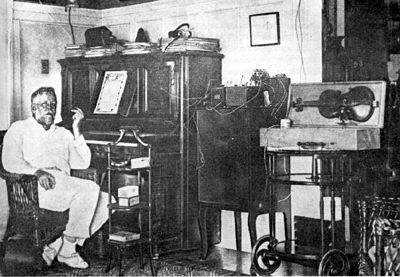
Science
Fessenden's Wireless
Reginald Aubrey Fessenden of Québec transmitted the first wireless voice broadcast near Washington, DC. On December 24, 1906, he made the first radio voice broadcast from Brant Rock, Mass.
-
August 29, 1907
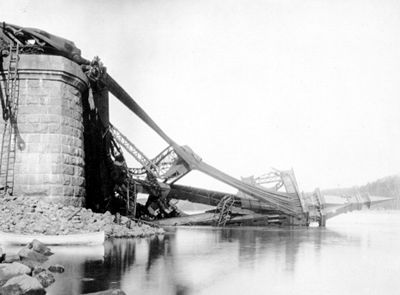
Science
Québec Bridge Disaster, 1907
Part of the Québec Bridge, the longest cantilever bridge in the world, collapsed, killing 75 workmen. Blame for the collapse was placed on the American engineer Theodore Cooper and faulty we plates.
-
October 11, 1910
Science
First Long-distance Transmission
An Ontario Hydro transmission line brought Niagara Falls-generated electricity to Berlin (Kitchener), Ont, the first long-distance transmission of electricity in Canada.
-
August 01, 1911

People
Faith Fyles Becomes First Woman Assistant Botanist at the Department of Agriculture
Faith Fyles was the first woman hired to the position of assistant botanist by the Central Experimental Farm (CEF), part of the Department of Agriculture (now Agriculture and Agri-Food Canada). In 1919, she became the department’s first botanical artist, male or female.
-
July 24, 1914
Science
Birth of Frances Kelsey
Frances Kelsey, the Canadian doctor hailed as a hero for withholding approval of the drug thalidomide in the United States, was born in Cobble Hill, BC. While employed at the US Food and Drug Administration in the early 1960s, Kelsey likely saved thousands of American children from severe deformities and disabilities by refusing to approve the drug for sale, despite the fact that it was already being prescribed in Europe and Canada. Her suspicions were confirmed in 1961, when reports emerged of birth defects among children born to women who had taken thalidomide during pregnancy.
-
February 14, 1916
Science
First Long-Distance Call
The first long-distance call in Canada was placed from Montréal to Vancouver, from the Ritz Carlton Hotel in Montreal to the Globe Theatre in Vancouver.
-
September 11, 1916

Science
Québec Bridge Disaster, 1916
A new centre span of the Québec Bridge fell into the river as it was being hoisted into position, killing 13 men.
-
March 18, 1918
Science
Daylight Saving Time Introduced
Daylight saving time was introduced in Canada by the federal government as a measure for increasing war production, emulating legislation in Germany and Britain.
-
May 21, 1919

People
Birth of Inventor and Research Scientist John A. Hopps
Trained as an electrical engineer, John A. Hopps was recruited to design a cardiac pacemaker with a team of scientists at the Banting Institute in Toronto while he was working on another project at the National Research Council of Canada (NRC). This resulted in the invention of a portable artificial external pacemaker. The device marked a significant medical milestone and laid the groundwork for implantable pacemakers.
-
July 27, 1921

Science
Banting and Best Isolate Insulin
Frederick Banting and Charles Best at the University of Toronto first isolated insulin. The first diabetes patient was treated on 11 January 1922. Banting and J.J.R. Macleod received the Nobel Prize for their achievement.
-
September 16, 1921
Science
Birth of Ursula Franklin
Physicist Ursula Franklin, who pioneered the development of archaeometry (the application of modern techniques of materials analysis to archaeology), was born in Munich, Germany.
-
October 25, 1923

Science
Banting and Macleod Win Nobel
The Nobel Prize for Medicine was awarded jointly to Frederick Banting and J.J.R. Macleod for the discovery of insulin.
-
November 02, 1925
Science
Debut of Electrical Recording
RCA Victor unveiled its electrical recording system. It had made the first electrical recording at the Metropolitan Opera House in New York on March 31.
-
May 16, 1930

Science
LaBine Finds Uranium
Prospector Gilbert LaBine discovered pitchblende, the chief source of uranium and radium, at Great Bear Lake, NWT.
-
May 07, 1935

Science
David Dunlap Observatory
The David Dunlap Observatory at Richmond Hill, Ont, was completed, the second largest in the world at that time.
-
January 01, 1936

People Science
Maude Abbott’s Atlas of Congenital Cardiac Disease Is Published
Published by the American Heart Association in 1936, Maude Abbott’s Atlas of Congenital Cardiac Disease was a groundbreaking text in cardiac research. The life-saving publication helped doctors to better understand and diagnose heart defects and to develop new ways to treat them.
-
February 19, 1938
Science
Mysterious Big Bang
A mysterious "big bang" woke thousands of people in Vancouver, yet no cause was ever found.
-
June 29, 1938

People
Birth of Biochemist Annette Herscovics
Annette Herscovics was born in Paris, France, and immigrated to Canada following the Second World War. She later studied at McGill University and worked there for several years before moving to Harvard Medical School. She returned to McGill as a full professor in 1981 and became known for her pioneering work on glycoproteins. She discovered where and how these modifications occur in our cells — a key development in the field of glycobiology.
-
October 17, 1941
Science
Death of John Stanley Plaskett
Astronomer John Stanley Plaskett died at Esquimalt, BC. As director of the Dominion Astrophysical Observatory north of Victoria, he pioneered research on the rotation of the Milky Way Galaxy.
-
December 02, 1942
Science
Fermi Achieves Chain Reaction
At the University of Chicago, Italian physicist Enrico Fermi achieved the first sustained nuclear chain reaction, leading to the atomic bomb and nuclear power.
-
July 22, 1947
Science
Canada's First Nuclear Reactors
The NRX reactor, the ancestor of Canada's unique CANDU reactors, "went critical" at Chalk River, Ont. The NRX was based on Canada's first nuclear reactor, ZEEP (1 watt of power), which was built at Chalk River in 1945.
-
October 23, 1950

Science
Bigelow, Callaghan and Hopps Unveil the Portable Artificial External Pacemaker
Cardiac surgeon Dr. Wilfred Bigelow, research fellow Dr. John Carter Callaghan, and Dr. John A. Hopps of the National Research Council of Canada delivered their findings on their newly invented portable artificial external pacemaker to the American College of Surgeons in Boston. The device was designed to send electric pulses to the heart, causing the heart to contract and pump blood to the body. It marked a significant medical milestone and laid the groundwork for implantable pacemakers.
-
September 15, 1956

Science
Reports of Canada’s First Successful Open-Heart Surgery
Dr. John Carter Callaghan performed Canada’s first successful open-heart surgery on 10-year-old Susan Beattie, who had a hole in her heart. On 15 November 1956, the Edmonton Journal described the event as “the greatest single advance in heart surgery in recent years.” Callaghan was also known for co-developing the portable artificial pacemaker.
-
August 29, 1959
Science
Birth of Chris Hadfield
Astronaut Chris Hadfield, who became the first Canadian among the support team at the Kennedy Space Center in Florida, was born at Sarnia, Ont.
-
February 20, 1962
Science
Glenn Orbits the Earth
Astronaut John Glenn was the first American to orbit the Earth when he circled it three times in the space capsule Friendship 7.
-
June 15, 1962
Science
Canada's First Space Vehicle
Canada's first space vehicle, a 11.3 kg non-orbiting instrument package, was launched from Wallops Island, Virginia.
-
September 29, 1962
Science
Alouette-I Launched
Canada's first orbiting satellite, Alouette-I, was launched from Vandenberg Air Force Base in California.
-
October 25, 1962
Science
Bedford Institute Opened
The Bedford Institute of Oceanography was opened, near Halifax.
-
July 15, 1965

Science
SOQUÉM Created
The Société québécoise d'exploration minière (SOQUÉM) was created.
-
November 09, 1965
Science
Electrical Blackout
The failure of a relay device of Ontario Hydro's Queenston generating station triggered a massive power failure extending from the Atlantic coast of the US to Chicago, and from Florida to southern Ontario, lasting up to 12 hours.
-
January 01, 1970
Science
Plant Gene Resources of Canada is Established
Plant Gene Resources of Canada (PGRC), Canada’s national seed gene bank, was founded to protect, preserve, and enhance the genetic diversity of Canada’s important agricultural plants and their wild relatives. PGRC has played a major role in protecting Canada’s agricultural crops and biodiversity while contributing to food security at home and around the world.
-
January 16, 1970
Science
Plans to Convert to Metric
The government announced plans to convert from the imperial to the metric system of measurement. A special commission was appointed to oversee the introduction of metric.
-
March 07, 1970

Science
Total Eclipse of the Sun
A total eclipse of the sun cast a shadow 160 kilometers wide along Canada's Atlantic coast, sweeping the length of Nova Scotia and across Newfoundland.
-
September 09, 1970
Science
DDT Pesticides Banned
The Canadian Government placed a complete ban on the use of DDT pesticides, effective 1 January 1971.
-
November 07, 1970
Science
Pierre-Laporte Bridge Opens
The Pierre- Laporte Bridge, over the St Lawrence River, was opened. The bridge originally was to be named the Frontenac Bridge, but it was changed to honour Laporte, Québec minister of labour and immigration, following his murder during the October Crisis.
-
February 10, 1971
Science
Air Pollution Fine Set
The federal Parliament set fines of up to $200 000 for air pollution.
-
April 05, 1971
Science
First CANDU
Gentilly nuclear power plant opened in Québec, the world's first nuclear plant with a reactor fuelled by natural uranium and cooled by ordinary water (the CANDU system).
-
April 29, 1971
Science
James Bay Project
Premier Robert Bourassa announced the development of the James Bay project.
-
November 02, 1971

Science
Herzberg Wins Nobel Prize
Gerhard Herzberg was awarded the Nobel Prize for chemistry for his contributions to the knowledge of electronic structure.
-
February 25, 1972
Science
Pickering Station Opened
The Pickering nuclear power plant officially opened, the largest single electricity producer in the world.
-
November 09, 1972
Science
Anik A-1 Launched
Canada launched the world's first geostationary domestic satellite, Anik A-1
-
April 20, 1973
Science
Anik A-2 Launched
The telecommunications satellite Anik A-2 was launched from Cape Canaveral, Fla. With its launch, Canada became the first country in the world to employ satellites for domestic communications.
-
December 07, 1973
Science
CANDU Deal with South Korea
Canada sold a CANDU reactor to South Korea.
-
May 18, 1974
Science
India Detonates Nuclear Device
India detonated a nuclear device using Canadian materials.
-
May 22, 1974
Science
Canada Suspends Nuclear Exports
The Canadian government suspended shipments of all nuclear equipment and materials to India, after India's detonation of a nuclear device.
-
April 01, 1975
Science
Weather Offices Use Celsius
Weather offices in Canada first used celsius to report temperatures. On September 1, metric was first used for rainfall and snowfall.
-
May 01, 1975
Science
Anik A-3 Launched
Communications satellite Anik A-3 was launched.
-
January 24, 1978
Science
Cosmos 954 Falls
Soviet satellite Cosmos 954 plunged into the atmosphere over northern Canada, spreading debris.
-
November 08, 1978
Science
Challenger Flies for First Time
The Canadair Challenger executive jet flew for the first time.
-
March 05, 1979
Science
Voyager 1 Encounters Jupiter
The space probe Voyager 1 made its closest encounter with Jupiter before moving on to Saturn.
-
June 05, 1980
Science
First AIDS-related Deaths
The US Centers for Disease Control reported 5 cases of pneumonia, which within a year were shown to be related to AIDS. By 1982, some 1600 cases had been reported worldwide.
-
November 13, 1981

Science
Canadarm Launched into Space
The Canadian-made Shuttle Remote Manipulator System (RMS), the Canadarm, was launched into space for the first time. It was carried aboard the Space Shuttle Columbia on mission STS-2, the second space shuttle. It performed well, exceeding all design goals and was declared operational one year later.
-
August 16, 1982
Science
Anik-D Launched
Anik D-1 was launched, replacing the aging Anik A and B satellites. Anik D-1 was the first commercial satellite built by a Canadian prime contractor, Spar Aerospace Limited.
-
October 05, 1984
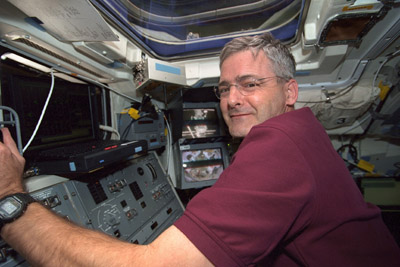
Science
Marc Garneau Enters Space
Marc Garneau was the first Canadian astronaut to enter space, during the 41-G mission of the American space shuttle Challenger.
-
January 30, 1985
Science
New Metric Policy
The federal government unveiled a new metric policy under which businesses would be allowed to sell and advertise food, gasoline and home furnishings in imperial measurements in addition to the mandatory metric units.
-
September 01, 1985

Science
Titanic Wreck Found
A US-led expedition discovered the wreck of the Titanic 590 km southeast of Newfoundland at a depth of 3,810 m.
-
September 25, 1985
Science
Tyrrell Museum Opens
Alberta Premier Peter Lougheed officially opened the $30-million Tyrrell Museum of Palaeontology at Drumheller.
-
January 28, 1986
Science
Challenger Explodes
The space shuttle Challenger exploded soon after takeoff, killing 7 astronauts.
-
December 08, 1986
Science
John Polanyi Shares Nobel
John Polanyi shared the Nobel Prize in Chemistry with Dudley Herschenbach and Yuan T. Lee.
-
August 25, 1989
Science
Voyager I Reaches Neptune
The US space probe Voyager I reached Neptune. Its pictures of Triton, Neptune's moon, revealed the existence of 2 additional moons.
-
April 24, 1990
Science
NASA Launches Hubble
NASA put the Hubble telescope into orbit. A flawed mirror and other defects were corrected in space in December 1993 by astronauts.
-
October 13, 1993
Science
Smith Wins Nobel Prize
Michael Smith won the Nobel Prize in chemistry for his research on site-directed mutagenesis.
-
July 16, 1994

Science
Comet Collides with Jupiter
Fragments of the comet Shoemaker-Levy collided with the planet Jupiter.
-
October 24, 1995
Science
New Emission Standards
The federal government and the provinces agreed that by the year 2001 all new cars sold in Canada must meet strict air pollution emission standards.
-
December 08, 1995
Science
Galileo Reaches Jupiter
After 6 years and a 3.7 billion km journey, the space probe Galileo reached Jupiter.
-
August 12, 1997
Science
Nuclear Reactors Shut Down
Ontario Hydro, North America's largest electric utility, announced that it would shut down the 7 oldest of its 19 nuclear reactors: 3 at the Bruce facility on lake Huron and 4 at Pickering on lake Ontario.
-
December 17, 1997
Science
New Pictures of Dying Stars
The Hubble Space Telescope showed images of the dying phases of stars in unprecedented detail, showing the expansion into red giants.
-
April 21, 1998

Science
Formation of Planets Discovered
Astronomers announced that they had observed evidence of the early formation of a group of planets, similar to our own solar system, around a young sun 220 light years away.
-
April 15, 1999
Science
New Solar System Found
Astronomers announced that they had discovered another solar system of multiple planets orbiting a star, some 44 light years away.
-
April 23, 1999
Science
New Human Ancestor Found
Paleontologists announced that they had discovered a fossil skull in Ethiopia that belonged to a previously unknown species of human ancestor.
-
May 27, 1999
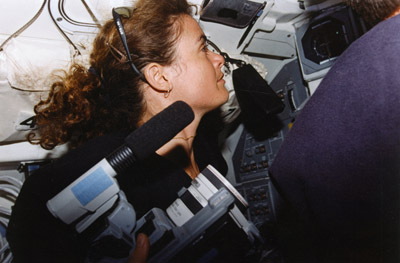
Science
Julie Payette in Space
Canadian astronaut Julie Payette took part in a space shuttle mission. She and a co-worker repaired faulty parts in the Russian space station Zarya's battery pack.
-
January 01, 2000
Science
Millennium Celebrations
The arrival of the year 2000 saw little technological disruption or acts of terrorism. The Y2K (Millennium) bug caused only minor computer problems.
-
February 01, 2003
Science
Shuttle Columbia Disaster
Space shuttle Columbia disintegrated over Tyler, Texas, killing all seven people on board, including the first Israeli astronaut, Ilan Ramon, and Kalpana Chawla of India. First clues pointed to failure of the heat-shielding tiles.
-
March 13, 2013

Science
Hadfield Becomes ISS Commander
Astronaut Chris Hadfield became the first Canadian commander of the International Space Station (ISS), succeeding astronaut Kevin Ford. A brief ceremony aboard the ISS included a broadcast of O Canada.
-
August 07, 2013
Science
Death of Tony Pawson
World-renowned researcher, Tony Pawson, whose discovery about how cells communicate and interact with each other transformed scientists' fundamental understanding of cancer and many other diseases, died in Toronto.
-
August 07, 2015
Science
Death of Frances Kelsey
Frances Kelsey, the Canadian doctor hailed as a hero for withholding approval of the drug thalidomide in the United States, died in London, ON, at age 101. While employed at the US Food and Drug Administration in the early 1960s, Kelsey likely saved thousands of American children from severe deformities and disabilities by refusing to approve the drug for sale, despite the fact that it was already being prescribed in Europe and Canada. Her suspicions were confirmed in 1961, when reports emerged of birth defects among children born to women who had taken thalidomide during pregnancy.
-
September 19, 2015
Science
Canadian Team Sets Record Speed for Human-Powered Vehicle
A team of Canadian engineers set a new world record for the fastest human-powered vehicle at an annual competition in Battle Mountain, Nevada, attaining a speed of 139.45 kilometres per hour. The vehicle, Eta — a high-efficiency recumbent bicycle enclosed in a carbon-fibre shell — is the work of Aerovelo, a company founded by University of Toronto alumni Todd Reichert and Cameron Robertson. Reichert pedalled the bike to a world record on 17 September 2015 and subsequently broke his own record twice to achieve the final speed.
-
May 18, 2016

Science
New Species of Dinosaur Identified
Paleontologists at the Canadian Museum of Nature in Ottawa announced that bones discovered a decade earlier in Montana are those of previously unknown species of dinosaur related to the triceratops. Nicknamed Judith, the Spiclypeus shipporum specimen now belongs to the museum’s world-class collection of horned dinosaur fossils.
-
July 22, 2016
Science
Death of Ursula Franklin
Physicist Ursula Franklin, who pioneered the development of archaeometry (the application of modern techniques of materials analysis to archaeology), died in Toronto, Ontario, at age 94.
-
April 11, 2017
People
Death of Dr. Mark Wainberg
Montreal-born molecular biologist Dr. Mark Wainberg, a renowned HIV/AIDS researcher and activist, died at the age of 71. In 1989, Wainberg discovered that the antiviral drug 3TC slowed the replication of HIV in the body — a breakthrough in the development of antiretroviral therapy.
-
May 18, 2017
Science
Death of Michael Bliss
Historian Michael Bliss died in Toronto, Ontario. One of Canada’s leading historians, Bliss wrote numerous prize-winning books on Canadian and medical history, including The Discovery of Insulin and William Osler: A Life in Medicine. He received many career honours, including the Order of Canada, honorary degrees from six universities and honorary fellowship in the Royal College of Physicians and Surgeons of Canada. For many years he was in demand as a lecturer, speaker and public intellectual in North America and Europe.
-
September 08, 2017

Science
Avro Arrow Model Found in Lake Ontario
The Raise the Arrow expedition announced that it discovered an Avro Arrow test model at the bottom of Lake Ontario. Images of the find show a jet covered in zebra mussels, which researchers planned to remove to discover more about the plane. The Malton, Ontario-based Arrow project began in the postwar years with the goal of creating one of the world’s fastest and most advanced interceptor aircraft, but it was controversially cancelled in 1959.
-
September 26, 2017
Science
Mona Nemer Named Canada’s Chief Scientist
Prime Minister Justin Trudeau appointed Mona Nemer, a pioneering heart researcher at the University of Ottawa, to the role of chief science advisor. The position involves promoting advancements in the sciences that will benefit Canadians, providing the government with impartial scientific advice, and reporting to the prime minister and the minister of health on the state of federal government science.
-
January 16, 2019
Science
BC Fossils Help Solve Evolutionary Riddle
The fossilized soft tissue of agnostids found in the 500-million-year-old Burgess Shale deposit helped researchers prove a connection between the bug-like creatures and trilobites, adding a new branch to the evolutionary tree of life.
-
April 06, 2021
Science
300-Million-Year-Old Fossil Found in New Brunswick
Halifax high school students and amateur paleontologists Rowan Norrad and Luke Allen discovered a 300-million-year-old fossilized dragonfly wing near Grand Lake, New Brunswick. The length of the wing, about 10 cm, indicated a likely wingspan of 25 cm — much larger than contemporary dragonflies. The fossil was sent to the National Museum of Natural History in Paris for further analysis.

